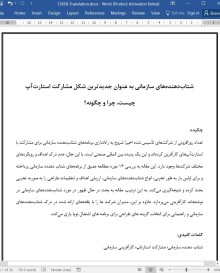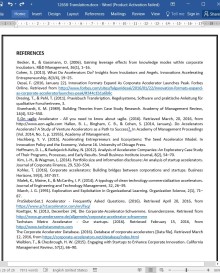
دانلود مقاله شتاب دهنده های سازمانی به عنوان جدیدترین شکل مشارکت استارت آپ
چکیده
تعداد روزافزونی از شرکت های تأسیس شده اخیرا شروع به راه اندازی برنامه های شتاب دهنده سازمانی برای مشارکت با استارت آپ های کارآفرین کرده اند و این یک پدیده بین المللی صنعتی است. با این حال، عدم درک اهداف و رویکردهای مختلف شرکت ها وجود دارد. این مقاله به بررسی 13 مورد مطالعه عمیق از برنامه های شتاب دهنده سازمانی پرداخته و برای اولین بار به طور تجربی، انواع شتاب دهنده های سازمانی، ارزیابی اهداف و تنظیمات طراحی را به صورت تجربی بحث کرده و نتیجه گیری می کند. به این ترتیب، مقاله به بحث در حال ظهور در مورد شتاب دهنده-های سازمانی در نوشتجات کارآفرینی می پردازد. علاوه بر این، مدیران شرکت ها را با یافته های ارائه شده در درک شتاب دهنده های سازمانی و راهنمایی برای انتخاب گزینه های طراحی برای برنامه های اشتغال نوپا یاری می کند.
1- مقدمه
اخیرا افزایشی در برنامه های شتاب دهنده سازمانی در سراسر جهان رخ داده است. به خصوص از آغاز سال های 2010، تعداد بیشتری از شرکت-ها این برنامه ها را برای درونی سازی فرصت های ارائه شده توسط استارتاپ های خارجی (Weiblen & Chesbrough، 2015) تاسیس کرده اند. در اوایل سال 2016، «پایگاه اطلاعاتی شتاب دهنده سازمانی» بیش از 65 برنامه فعال در 25 کشور (پایگاه اطلاعاتی شتاب دهنده سازمانی، 2016) را فهرست کرد، در حالی که منابع دیگر، تعداد بیش از 120 برنامه (Desai، 2016) را تخمین زده اند.
در مقابل طرح های سرمایه گذاری شرکت های موجود، شتاب دهنده های سازمانی نه تنها حمایت مالی مستقیم و غیرمستقیم را برای استارت آپ ها فراهم می کنند، بلکه هدف شان دستیابی به اهداف اضافی با مدل های جامع تر پشتیبانی استارت آپ است. برنامه های شتاب دهنده سازمانی اهداف مختلفی را شامل می شود، از جمله تلاش برای حمایت از کارآفرینان و استارت آپ ها (ProSiebenSat.1، 2016)، برای «توسعه ایده های جدید کسب و کار و ورود آن ها به زندگی» (E.On:agile Accelerator, 2016) و «حمایت از تحول دیجیتال» (Techstars Metro Accelerator، 2016).
شرکت هایی که شتاب دهنده های سازمانی را راه اندازی می کنند از صنایع گوناگون هستند، به عنوان مثال، والت دیزنی و اسپرینگ در ایالات متحده، Citigroup و سامسونگ در اسرائیل، METRO و Bayer در آلمان. چندین برنامه شتاب دهنده سازمانی دارای مکان-های مختلف بین المللی هستند. مثلا برنامه شتاب دهنده مایکروسافت در هفت شهر در اروپا، آسیا، آمریکای شمالی و شرق میانه و گوگل در سه کشور آمریکای لاتین است. به همین ترتیب، شتاب دهنده های سازمانی یک پدیده جهانی و چندصنعتی هستند.
7- نتیجه گیری
تعداد شتاب دهنده های سازمانی در سال های اخیر به طور قابل توجهی افزایش یافته است. با این حال، اهداف و انگیزه-های مختلف شرکت های ایجاد شده در پشت این برنامه ها اغلب نامفهوم هستند. در این مقاله، ما نشان می دهیم که چهار نوع شایع از شتاب دهنده های سازمانی وجود دارد که درمورد اهداف و تنظیمات تمرکز و سازمان برنامه شان، منحصر به فرد هستند. درک موجود به شتاب دهنده های سازمانی به عنوان یک شکل بالقوه تعامل با استارتاپ های کارآفرینی برای دستیابی به اهدف نوآوری بیرونی اما تامینی از داخل اشاره می کند. مطالعه عمیق تجربی ما، که یکی از جامع ترین مطالعات در این زمینه است، به طور قابل توجهی این درک اولیه را گسترش می دهد. بر اساس 13 مورد مطالعه شتاب دهنده های سازمانی، از جمله داده های دو سطحی از برنامه و استارتاپ، مطالعه ما تصویر واضح تر از جنبه های مختلف از اهداف استراتژیک ارائه می دهد.. تجزیه و تحلیل موردی ما نشان می دهد که ایستگاه ردیابی اطلاعات الکترونیکی، سرمایه گذار زنجیره ارزش، و شتاب دهنده های سازمانی آزمایشگاه معیار سه نوع شتاب دهنده هستند که هر کدام دارای هدف استراتژیک خاصی هستند. علاوه بر این، مطالعه ما نشان می دهد که شتاب دهنده های سازمانی شکارچی تک شاخ به طور عمده برای اهداف مالی استفاده می شود، مفهومی که قبلا مشخص نشده است.
با این حال، ظهور اخیر شتاب دهنده های سازمانی بدون انتقاد نیست و رسانه ها حتی به این پدیده به عنوان «اشباع شتاب دهنده سازمانی » (Roettger، 2013) اشاره می کنند. علاوه بر این استدلال می شود که روند فعلی می تواند راه اندازی برنامه های بیشتر بر اساس اصل «من نیز هم» را تشویق کند. اشکال دیگر انکوباسیون های تجاری طوری در نظر گرفته می شوند که پیش از ارائه نتایج به شرکت والدین 5-7 سال زمان بین شروع و اتمام فرآیند تولید داشته باشند (Becker & Gassmann، 2006؛ Weiblen & Chesbrough، 2015). بنابراین، این هنوز هم دیده می شود، اگر شتاب دهنده های سازمانی بتوانند به اهداف مختلف استراتژیک و مالی مشخص شده در مطالعه ما دست یابند. این موفقیت، پایه ای برای شتاب دهنده های سازمانی به عنوان یک مفهوم موثر و طولانی مدت برای تعامل با شرکت های تاسیس شده با استارتاپ کارآفرینی ایجاد خواهد کرد.
با شفافیت شتاب دهنده های سازمانی ایجاد شده توسط تجزیه و تحلیل موردی و گسترده ما، ما امیدواریم که به درک بهتر پدیده شتاب دهنده های سازمانی کمک کنیم، اساس تحقیقات بیشتری در مورد اثربخشی این برنامه ها را ایجاد کنیم و مشاغلی با بینش های ارزشمند برای بهبود یا ایجاد برنامه های جدید شتاب دهنده سازمانی فراهم کنیم.
ABSTRACT
An increasing number of established companies have recently started to launch corporate accelerator programs to engage with entrepreneurial startups, making this a worldwide, cross-industrial phenomenon. Nevertheless, there is a lack of understanding of the various objectives and approaches adopted by companies. This article examines 13 indepth case studies of corporate accelerator programs and is the first to empirically derive and discuss a typology for corporate accelerators, assessing objectives and design configurations. Thereby, the article contributes to the emerging discussion about corporate accelerators in corporate entrepreneurship literature. Moreover, the findings provide corporate managers with an understanding of corporate accelerators and guidance for how to make design choices for startup engagement programs.
1. INTRODUCTION
here has been a recent surge of corporate accelerator programs worldwide. Especially since the beginning of the 2010s, an increasing number of companies have established these programs to internalize the opportunities presented by external startups (Weiblen & Chesbrough, 2015). By early 2016, the “Corporate Accelerator Database” listed more than 65 active programs in 25 countries (The Corporate Accelerator Database, 2016), whereas other sources estimate there to be more than 120 programs (Desai, 2016).
In contrast to the existing corporate venture capital initiatives, corporate accelerators not only provide direct and indirect financial support to startups, but also aim to achieve additional objectives with more comprehensive startup support models. Self-descriptions of corporate accelerator programs provide a variety of objectives, including endeavors to “support entrepreneurs and startups” (ProSiebenSat.1, 2016), to “develop new business ideas and bring them to life” (E.On :agile Accelerator, 2016), and to “support digital transformation” (Techstars Metro Accelerator, 2016).
Companies launching corporate accelerators are from diverse industries, for instance, Walt Disney and Spring in the USA, Citigroup and Samsung in Israel, and METRO and Bayer in Germany. Several corporate accelerator programs have multiple international locations, such as Microsoft’s accelerator program in seven cities in Europe, Asia, North America, and the Middle East, and Google’s in three countries in Latin America. As such, corporate accelerators are a global, cross-industrial phenomenon.
7. CONCLUSION
Corporate accelerators have increased in number significantly within recent years. However, the different objectives and motives of the established companies behind these programs often remain unclear. In this article, we show that there are four common types of corporate accelerators that are unique regarding their objectives and their configurations of program focus and organization. Existing understanding refers to corporate accelerators as one potential form of engagement with entrepreneurial startups for pursuing the objective of insourcing outside innovation. Our in-depth empirical study, which is one of the most comprehensive studies in this field, significantly extends this basic understanding. Based on 13 case studies of corporate accelerators, including two-level data from both the program and startup level, our study provides a clearer picture of the different facets of the strategic objectives. Our case analysis shows that the listening post, value chain investor, and test laboratory corporate accelerators are three types, each with specific strategic objectives. Furthermore, our study reveals that the unicorn hunter corporate accelerators are used for mainly financial purposes, a concept that has not been identified previously.
However, the recent emergence of corporate accelerators is not without criticism, and media even refers to the phenomenon as “corporate accelerator glut” (Roettger, 2013). It is furthermore argued that the current trend could encourage the launch of further programs based on the “me-too” principle. Other forms of business incubations are considered to have a lead-time of five to seven years before delivering results to the parent company (Becker & Gassmann, 2006; Weiblen & Chesbrough, 2015). Therefore, it remains to be seen if corporate accelerators can achieve the various strategic and financial objectives outlined in our study. This success would set the basis for corporate accelerators being an effective and long-lasting concept for the engagement of established companies with entrepreneurial startups.
With the transparency of corporate accelerators created by our extensive case analysis, however, we hope to contribute to a better understanding of the overall corporate accelerator phenomenon, set the basis for further research on the effectiveness of these programs, and provide practitioners with valuable insights for improving existing or establishing new corporate accelerator programs.
چکیده
1- مقدمه
2- بررسی نوشتجات
3- روش تجزیه و تحلیل
3-1 روش شناسی
3-2 جمع اوری نمونه و داده ها
4- نتایج تجزیه و تحلیل تجربی
4-1 اهداف شتاب دهنده سازمانی
4-1-1 اهداف اولیه
4-1-1-1 اهداف مالی
4-1-1-2 اهداف استراتژیک
4-1-2 اهداف دیگر
4-2 تنظیمات شتاب دهنده شرکت
4-2-1 تمرکز برنامه
4-2-1-1 موقعیت فرصت
4-2-1-2 منطق استراتژیک
4-2-1-3 تمرکز صنعت
4-2-1-4 مشارکت صاحبان سهام
4-2-1-5 مرحله سرمایه گذاری
4-2-2 سازمان برنامه
4-2-2-1 شریک خارجی
4-2-2-2 ارتباط با شریک
4-2-2-3 تجربه رهبری
5- نوع شناسی شتاب دهنده شرکت: چهار نوع متفاوت
5-1 ایستگاه ردیابی اطلاعات الکترونیکی
5-2 سرمایه گذار زنجیره ارزش
5-3 آزمایشگاه معیار
5-4 شکارچی تک شاخ
6- بحث و مفاهیم
6-1 پیوند دادن اهداف و تنظیمات طراحی
6-1-1 تمرکز برنامه
6-1-2 سازمان برنامه
6-2 عوامل موفقیت برای شتاب دهنده های سازمانی
7- نتیجه گیری
منابع
ABSTRACT
1. INTRODUCTION
2. LITERATURE REVIEW
3. ANALYSIS APPROACH
3.1 Methodology
3.2 Sample and Data Collection
4. RESULTS OF EMPIRICAL ANALYSIS
4.1 Corporate Accelerator Objectives
4.1.1 Primary Objectives
4.1.1.1 Financial Objectives
4.1.1.2 Strategic Objectives
4.1.2 Additional Objectives
4.2 Corporate Accelerator Configurations
4.2.1 Program Focus
4.2.1.1 Locus of Opportunity
4.2.1.2 Strategic Logic
4.2.1.3 Industry Focus
4.2.1.4 Equity Involvement
4.2.1.5 Venture Stage
4.2.2 Program Organization
4.2.2.1 External Partner
4.2.2.2 Connection to Parent
4.2.2.3 Leadership Experience
5. CORPORATE ACCELERATOR TYPOLOGY: FOUR DISTINCT TYPES
5.1 Listening Post
5.2 Value Chain Investor
5.3 Test Laboratory
5.4 Unicorn Hunter
6. DISCUSSION AND IMPLICATIONS
6.1 Linking Objectives and Design Configurations
6.1.1 Program Focus
6.1.2 Program Organization
6.2 Success Factors for Corporate Accelerators
7. CONCLUSION
REFERENCES
- اصل مقاله انگلیسی با فرمت ورد (word) با قابلیت ویرایش
- ترجمه فارسی مقاله با فرمت ورد (word) با قابلیت ویرایش، بدون آرم سایت ای ترجمه
- ترجمه فارسی مقاله با فرمت pdf، بدون آرم سایت ای ترجمه



